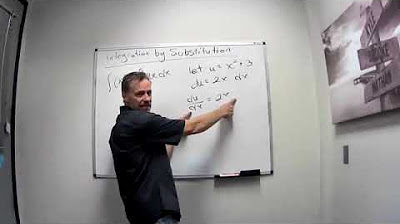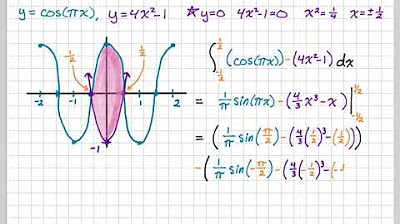Calculus Divide and Integrate
TLDRThe video script discusses the common mathematical technique of 'divide first, then integrate' for solving integrals where the numerator's degree is greater than or equal to the denominator's degree. The presenter dives into three examples to illustrate this method. In the first example, the integral of (x^2 + 3x + 2) over (x + 3) is simplified through long division, resulting in (x + 2) over (x + 3), which is then integrated to yield (1/2)x^2 + 2x + ln|x + 3| + C. The second example involves the integral of (2x^2 - 5x + 1) over (x - 4), which after division and integration results in x^2 + 3x + 13 + ln|x - 4| + C. The third example demonstrates the integral of (x^2) over (x^2 + 4), where the presenter uses a trick of adding and subtracting the same term to simplify the integrand before integrating to get x - 2arctan(x/2) + C. The video emphasizes the importance of practice and understanding the technique, which is often followed by natural logarithm or arctangent results in the remainder term.
Takeaways
- 📚 **Divide First, Integrate Later**: When the degree of the numerator in an integral is greater than or equal to the degree of the denominator, it's necessary to perform polynomial division before integrating.
- 🔢 **Long Division Technique**: The video demonstrates the use of long division to simplify the integrand, which is a common method for dealing with polynomials.
- 🛠️ **Matching Degrees**: The process of long division involves multiplying the denominator by a term that matches the degree of the numerator to facilitate the division.
- 📉 **Cancelling Terms**: During the division, like terms in the numerator and denominator are cancelled out, simplifying the integrand.
- 🧮 **Rewriting the Integrand**: After division, the original integrand can be rewritten in a simpler form that is easier to integrate.
- 📈 **Integration of Resultant Terms**: Once the integrand is simplified, each term can be integrated separately, often resulting in terms like natural logarithms or arcs.
- 🔁 **Synthetic Division Alternative**: Although synthetic division could be used for linear denominators, the video prefers long division for its clarity.
- 📝 **Natural Log and Arc Terms**: Common outcomes of integration after division are natural logarithms and arcs, which are standard forms in calculus.
- 🤔 **Experience Matters**: The level of experience with calculus can affect the approach to rewriting and integrating, with more experienced individuals potentially recognizing patterns more quickly.
- ➗ **Division by Constants**: If the denominator is a constant multiple of the numerator, dividing by that constant simplifies the integrand, as shown in the example with \( x^2 + 4 \).
- 🎓 **Plus-Minus Trick**: The video introduces a trick for rewriting the integrand by adding and subtracting the same term to match the denominator, which can simplify the integration process.
Q & A
What is the technique discussed in the video?
-The video discusses the technique of dividing first and then integrating when dealing with integrals where the degree of the numerator is greater than or equal to the degree of the denominator.
Why is long division used in the examples?
-Long division is used to simplify the integrand by dividing the numerator by the denominator, which helps in breaking down the integral into simpler parts that can be more easily integrated.
What is the first integral example given in the video?
-The first integral example is ∫(x^2 + 3x + 2) / (x + 3) dx, which after performing long division, simplifies to ∫(x + 2) / (x + 3) dx.
What is the result of integrating the simplified form of the first example?
-The result of integrating the simplified form is (1/2)x^2 + 2x + ln|x + 3| + C.
What is the second integral example provided in the video?
-The second integral example is ∫(2x^2 - 5x + 1) / (x - 4) dx, which after long division, simplifies to ∫(2x + 3 + 13) / (x - 4) dx.
How does the video handle the second integral example?
-The video rewrites the integrand as 2x + 3 + 13 / (x - 4) and then integrates each part, resulting in x^2 + 3x + ln|x - 4| + C.
What is the third integral example discussed in the video?
-The third integral example is ∫(x^2) / (x^2 + 4) dx, which even though the degrees are the same, the video still performs division to simplify the integral.
What trick does the video mention for simplifying the third integral example?
-The video mentions a 'plus 4 minus 4' trick, which involves adding and subtracting the same term to match the denominator in the numerator, thus simplifying the integral.
What is the final simplified form of the third integral example after applying the trick?
-The final simplified form after applying the trick is ∫(1 - 4 / (x^2 + 4)) dx, which integrates to x - (1/2)arctan(x/2) + C.
What are the two common outcomes mentioned when dealing with the remainder term after division in integration?
-The two common outcomes mentioned are ending up with a natural logarithm (ln) or an arctangent (arctan) function in the integral.
Why is it recommended to practice the 'plus 4 minus 4' trick?
-Practicing the 'plus 4 minus 4' trick helps in efficiently simplifying the integrand by matching the denominator in the numerator without changing the value of the integral, which can often simplify the integration process.
What is the purpose of using placeholders in the long division process as mentioned in the video?
-Using placeholders in the long division process helps to keep track of the steps and prevents errors, especially when dealing with more complex polynomial divisions.
Outlines
📚 Integrating by Division: A Common Technique
This paragraph introduces a mathematical technique for integrating functions where the degree of the numerator is greater than or equal to the degree of the denominator. The speaker demonstrates the process through an example involving the integral of ( x^2 + 3x + 2 ) over ( x + 3 ). The method involves performing long division to simplify the integrand, which then allows for easier integration. The result of the integration is expressed as ( 1/2x^2 + 2x + ln|x + 3| + C ), where ( C ) is the constant of integration.
🔍 More Division and Integration Examples
The second paragraph continues the discussion on integrating by division with two additional examples. The first example involves the integral of ( 2x^2 - 5x + 1 ) over ( x - 4 ), which after division and integration results in ( 2x + 3 + 13ln|x - 4| + C ). The second example deals with the integral of ( x^2 ) over ( x^2 + 4 ), which after applying a strategic addition and subtraction of terms to simplify the integrand, leads to the result ( x - 2 + 1/2arctan(x/2) + C ). The speaker also mentions a common trick called 'plus 1 minus 1' for simplifying the integrand, which is a useful technique for integrands that match the denominator.
Mindmap
Keywords
💡Divide first and then integrate
💡Degree of a polynomial
💡Long division
💡Integrand
💡Natural logarithm
💡Arctan function
💡Synthetic division
💡Polynomial
💡Antiderivatives
💡Integration
💡Plus-minus trick
Highlights
Discussed a common technique of dividing first and then integrating for polynomial functions.
Demonstrated the process using the integral of x squared plus 3x plus 2 over x plus 3 dx.
Performed actual long division to simplify the integrand before integrating.
Resulted in the integrand being X plus 2 over X plus 3 dx after division.
Integrated each part of the simplified integrand to get 1/2 x squared plus 2 and natural log of the absolute value of x plus 3 plus C.
Moved on to another example with the integral of 2x squared minus 5x plus 1 over x minus 4.
Highlighted the preference for long division despite the linear term in the denominator.
Revealed the common outcome of natural log or arc functions after division.
Integrated the simplified integrand to obtain x squared plus 3x plus 13 and natural log of the absolute value of x minus 4 plus C.
Tried a third example with the integral of x squared over x squared plus 4 dx, where the degrees are the same.
Used placeholders for clarity during the division process.
Simplified the integrand to 1 minus 4 over x squared plus 4 dx.
Integrated to get x plus 1/2 arctan of x over 2 plus C.
Suggested a simplification of the answer to x minus 2 or 10 of x over 2 plus C.
Introduced a trick called 'plus 4 minus 4' to match the denominator in the numerator.
Explained that adding and subtracting the same term does not change the value but simplifies the integrand.
Encouraged practice of the 'plus 4 minus 4' trick for efficiency in integration problems.
Concluded with a summary of the method and wished good luck to the viewers.
Transcripts
5.0 / 5 (0 votes)
Thanks for rating:





